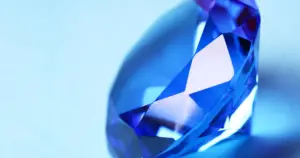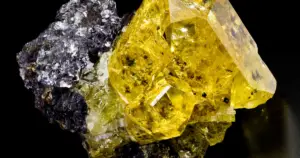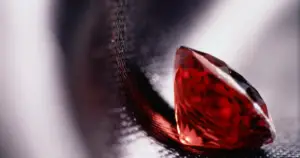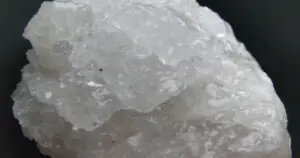How To Identify Clear Quartz?
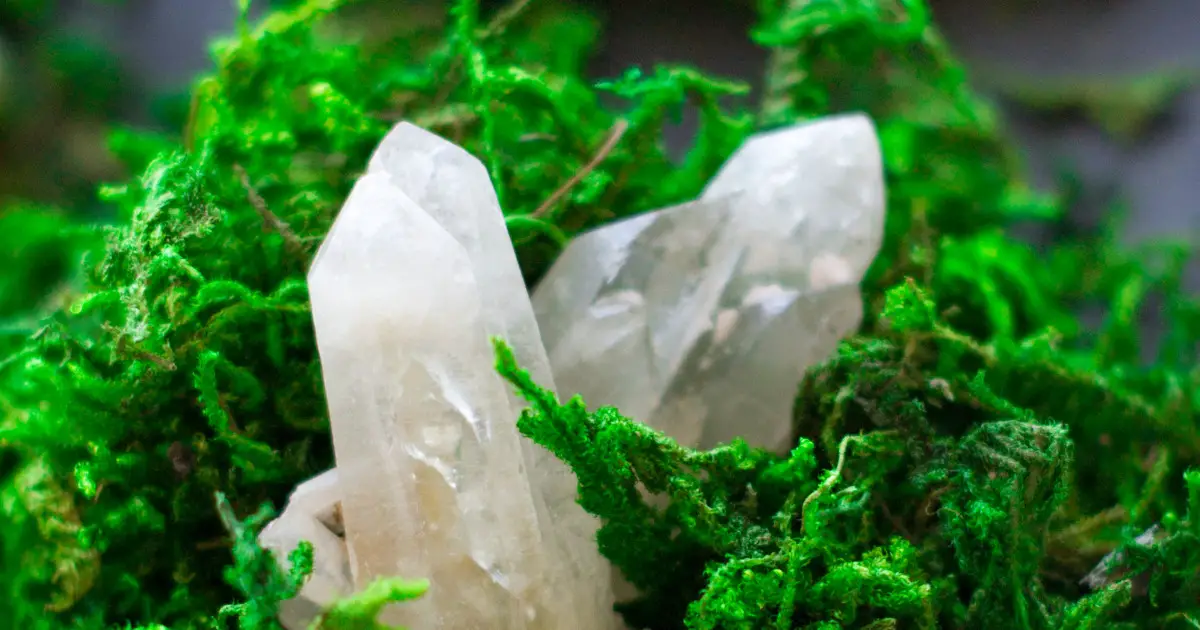
Quartz is a prevalent mineral, and its gleaming or crystalline look attracts the attention of many collectors. The Mohs hardness of 7 makes Quartz not break the stone smoothly when broken. On white porcelain, it does not leave a visible streak. It has a glassy glitter or sheen to it.
There are various ways to recognize clear Quartz. Let us explore the ways to identify Clear Quartz.
Table of Contents
What is Clear Quartz?
In the earth’s crust, Clear Quartz is the most abundant mineral. Besides sedimentary, igneous, and metamorphic rocks, Clear Quartz can also be present in geodes and other geological formations. Although many different types of Quartz vary in color and crystal type, rock is a general term for the crystal clear type. Silica and oxygen constitute Quartz, and it has remarkable physical properties.
Suggested Reading: Petalite Crystal: Meaning, Healing Properties, Benefits And Uses
How to Identify Clear Quartz?

Check for Hardness
Draw on the crystal surface with a pocket knife to test the hardness. The quartz pocket is more complex than the knife blade. Therefore, you should not see scratches on the surface of the crystal.
Conduct a Streak and Color Test
Rub the crystal on the streak plate to test for streak and its color presence. Streak is a mineral color in powder form. Quartz can be white or colorless. Streak plates have almost the same hardness as Quartz so you can see the streak without the white line or color.
Conduct a Cracks and Crevices Test
Break the crystals with a hammer to examine cracks and crevices. Quartz crystal does not have good cleavage or smooth planes of weakness in the structure, allowing crystals to break. Instead, the rock crystal becomes fractured, showing a rough surface with breaks. Often, the fracture exhibits a swirl pattern, also known as a conchoidal fracture.
How Can You tell if a stone is Crystal Quartz?
If you buy crystals online, it might not be easy to know if they are pure. Even after reading them over the years, people can still be fools. So it is essential to become smart enough to find out which crystal stores are popular online. If you are trying to figure out how to tell whether the clear Quartz is real or fake at first is frustrating.
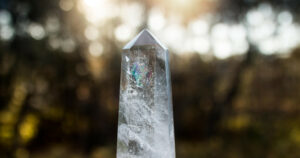
If you buy crystals from places like AliExpress, Amazon, etc., you must be careful and keep in mind that you may get counterfeit. But sometimes, the price for new crystal collectors is so exciting that it is hard to resist. The genuine crystal and spiritual shops are very careful about what they sell.
If you buy a clear quartz crystal online, you may wonder if it is fake. There is a lot of misinformation on how to tell if your clear quartz crystal is natural.
Let us determine whether your clear quartz crystal is authentic, genuine, and original. There are even some easy ways to tell if it is Glass. If your clear Quartz makes the object behind it bigger, it must be fake. It doesn’t seem right.
Can clear quartz be in the sun? Read here to know.
Test the Extension Behind Clear Quartz
One common misconception about clear Quartz (or crystal in general) is that the writing or text behind it should not be extensive. It is not an accurate test and will not tell you whether the crystal is genuine or counterfeit.
Real clear Quartz (and any other sawn crystal) expands and distorts the text depending on the crystal size. Light bends through the curves in a crystal when it has a concave shape and a curving structure, changing the view from behind you. So let’s throw out that “test” – it will not tell you if your crystal is natural.
Check for the Mohs scale
Mohs scale is a scientific method for comparing the hardness of minerals developed in 1812. German geologist Friedrich Mohs discovered the level of hardness used to test minerals and other materials.
All minerals have different marks, and this is a test to tell if your crystals are genuine. For instance, Clear Quartz should have an average score of 7. On the other hand, Glass has an average score of 5.5 -7.
So here is what you can do. Take your clear Quartz and try to draw a piece of Glass. If this is true, it scratches the Glass; else, if it is fake clear Quartz, it will not scratch the Glass. Of course, this can be not easy with polished tumblers/pendants, etc., but this test works best if you have a clear quartz point or rough clear Quartz!
Check for Air Bubbles in the Crystal
The simulation consists of transparent quartz air bubbles. Accurate, clear Quartz has no air bubbles but Glass. It’s that simple. The air bubbles in the Glass look like small balls that do not spin. The glass formation process is very different from the quartz formation that occurs naturally on earth.
Examine your clear Quartz closely. The bubbles are perfectly rounded. It May contain real clear quartz inclusions, but not always.
It is possible to see minor scratches, cracks, and inclusions in the clear quartz crystal. But sometimes, crystal stores sell better, higher-quality clear Quartz, which is almost completely obvious. That does not mean they are fake. It is possible to see some cracks and inclusions closely, but they do not appear abundant to the naked eye.
Natural Clear Quartz Is pleasant To Touch. Authentic, clear quartz crystals are often cooler to the touch than Glass. The Glass feels room temperature, the Quartz being a little cold in your hand. Put your clear quartz crystal on the counter for a few hours and remove it. If it’s a bit cold, it’s probably authentic.
How do you know if Quartz is Clear or Calcite?
Quartz and calcite are common minerals in rocks worldwide. The two minerals are in different colors, such as purple, white, brown, gray, and colorless, so they sometimes look the same. However, these two minerals have many different physical and chemical properties that separate them.
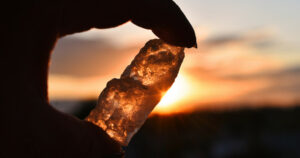
Check for Hardness
Mineral hardness is an important characteristic used by scientists in sample identification. Quartz is almost four times harder than calcite. A piece of Quartz can scratch the pattern of calcite but does not scratch the calcite quartz. If you each have its pattern, try scratching one pattern with another to see the difference in hardness. You can also test the hardness of these two minerals using a pocket knife. Knife blades have a hardness value between calcite and Quartz. The knife can scratch calcite crystals but not scratch.
Look for the Crystal Shape
Quartz and calcite crystals have different crystal sizes. Besides rhombohedrons, calcite also forms prismatic crystals, scalenohedrons, and other less common crystal forms. The most common kind of Quartz is a hexagonal prism with a six-sided pyramid on each side of the crystal. Many quartz crystals may not exhibit the correct crystal shape or appear like a three-sided pyramid at the terminus.
Look for Cracks and Crevices
Cleavage is the ability to break weak bonds in a crystal structure—a smooth surface formation due to braking. Calcite exhibits a rhombic fissure, i.e., it splits with three levels of weakness, creating a rhombic shape for the crystal. Quartz does not have a substantial crack, but the crystal has cracks and a rough surface on the broken crystal. Quartz cracks are described as conical while displaying a swirl pattern on a broken surface stone.
Observe the Chemical Composition
Quartz is a silicon dioxide crystal, whereas calcite is a calcium carbonate mineral. You can’t identify the difference in mineral composition by looking at it, but you can run a test to establish that the crystal you have is calcite. When calcium carbonate interacts with an acid, bubbles form on the crystal surface. To test your sample, add a tiny amount of weak hydrochloric acid, lemon juice, or vinegar to it and check for bubbles. Quartz is unaffected by dilute acid.
Do Clear Quartz Magnify?
Yes, however, it’s all too simple to buy glass instead of Clear Quartz in the incorrect locations. The reality is that almost all crystals polished into any shape, whether tumble, palm stone, sphere, or other, will magnify due to their refraction index. If you’re interested in science, many more scientific explanations are accessible on the internet.

Still, in summary, fundamental physics indicates how much the light will slow down and “bend” as it penetrates the substance. Light is slowed down by whatever object it penetrates, including glass, Quartz, water, and even air.
Where To Find Clear Quartz In Nature?
Quartz crystals may be present in a variety of nations and geologic conditions. The United States (especially Arkansas) and Brazil are major producers of natural quartz crystals. Except as a gemstone, people do not utilize natural Quartz as it is present in nature (particularly in electrical applications). Natural quartz crystals have an excessive amount of chemical impurities and physical defects. Consequently, a commercial technique for producing pure, perfect, electronics-grade Quartz was created.
The Quartz utilized in the industry is “cultured quartz,” which is quartz crystals cultivated extremely carefully in highly regulated laboratory settings. Every year, there is a production of around 200 metric tonnes of cultivated Quartz. A “seed crystal” is required to form cultured quartz crystals. This seed crystal serves as the foundation for the created crystal.
Conclusion
Quartz crystals are usually hexagonal prisms, ending in a six-sided pyramid at each end. No matter the form of Quartz crystals, they may not always be perfect. Your design may include only the barrel of the prism and only the three sides of the pyramid or the last pyramid. You must test our clear Quartz crystal today.
